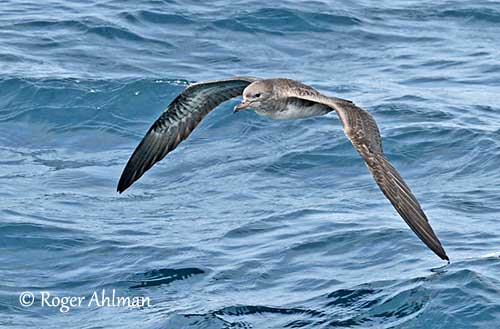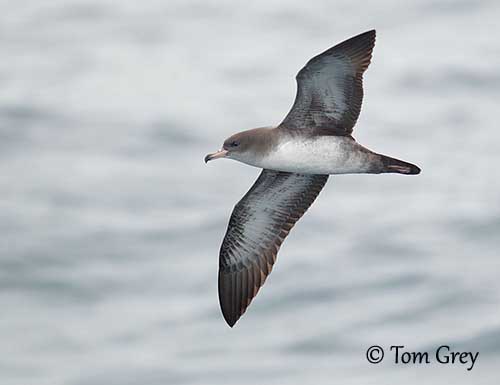
Fr: Puffin à pieds roses
Ang: Pink-footed Shearwater
All: Rosafuß-Sturmtaucher
Esp: Pardela Patirrosa
Ita: Berta piedirosa
Nd: Chileense Grote Pijlstormvogel
Sd: Rosanäbbad lira
Photographers:
Roger Ahlman
Pbase Galleries Peru and Ecuador
Tom Grey
Tom Grey's Bird Pictures
Text by Nicole Bouglouan
Sources:
HANDBOOK OF THE BIRDS OF THE WORLD vol 1 by Josep del Hoyo-Andrew Elliot-Jordi Sargatal - Lynx Edicions - ISBN: 8487334105
What Bird-The ultimate Bird Guide (Mitchell Waite)
Bird Web (Seattle Audubon Society)
Ocean Wanderers "Ride the Wave"
Pink-footed Shearwater
Ardenna creatopus
Procellariiformes Order – Procellariidae Family
INTRODUCTION:
The Pink-footed Shearwater occurs in the Pacific Ocean and is a transequatorial migrant. It breeds on three islands off the central Chilean coast, and moves N to spend the winter off the coast of North America. Like most Procellariidae, it nests in burrow.
The Pink-footed Shearwater is affected by introduced predators on its breeding islands, especially rats and coatis, but also cats and dogs. Outside the breeding season, it is found in open ocean and often well offshore. It tends to follow the fishing boats from which it can get fish discards, but it is at risk of being hooked or entangled in fishing gear.
The Pink-footed Shearwater is a pale-bellied version of the Flesh-footed Shearwater.

DESCRIPTION OF THE BIRD:
Biometrics:
Length: 45-48 cm
Wingspan: 109-115 cm
Weight: 580-900 g
The Pink-footed Shearwater is a large, brown and white seabird with long, slender wings. It has greyish-brown upperparts with darker head and neck, flight-feathers and tail.
The underparts are white, with dark grey trailing edge on the underwing, broader at wing tip. Throat, body sides and lower belly are variably marked with greyish.
The head is grey-brown to below the eye.
Some birds are darker (0,1% of population) and have much darker underwing, head, neck and breast sides, contrasting with the white belly.
The palest individuals show whiter underwing.
The bill is pinkish to flesh-coloured, with dark-grey tip and sometimes culmen too. The eyes are dark brown. Legs and webbed feet are pink, with sometimes greyish outer toes.
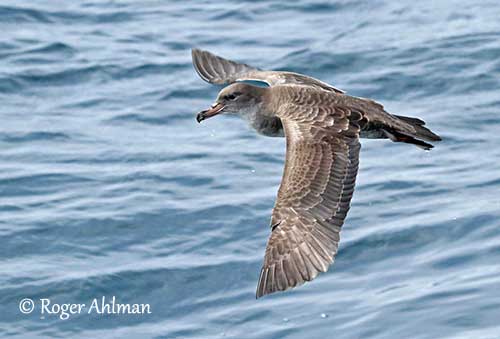
Male and female are similar, but the female is slightly smaller overall.
The juvenile resembles adult. It is in fresh plumage in May/July.
RANGE:
The Pink-footed Shearwater breeds on islands off the central Chilean coast including Juan Fernandez Islands, on Robinson Crusoe Island (formerly Más a Tierra Island), Santa Clara Island, and also Mocha island, off WC Chile.
Outside the breeding season, it moves towards the subarctic waters of Pacific Ocean. It usually occurs well off the W coasts of USA during the warmer months and as far up the coasts as British Columbia.
It can be seen occasionally around Australia and New Zealand.
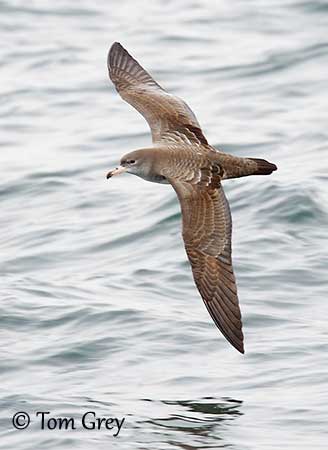
HABITAT:
The Pink-footed Shearwater is a pelagic seabird. It comes to land only for breeding in excavated burrow among scattered vegetation, but also on mountain ridges in forest habitat and in open areas close to sea-level, depending on the island.
Outside the breeding season, it occurs over the continental shelf in offshore shallow waters.
CALLS AND SONGS: SOUNDS BY XENO-CANTO
The Pink-footed Shearwater gives nasal and squawking calls while foraging in groups. It is usually more vocal in flight than on the ground.
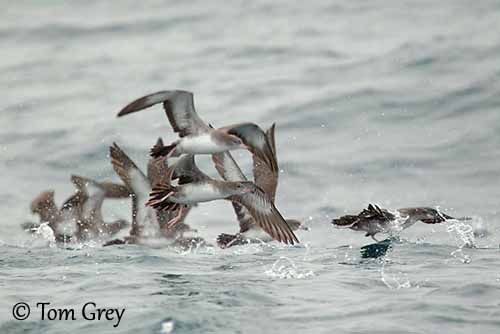
BEHAVIOUR IN THE WILD:
The Pink-footed Shearwater feeds mainly on small fish, squid and crustaceans. It performs plunge-diving from flight, and may occasionally completely submerge for a few seconds. It swims underwater with the wings while pursuing a prey. It also snatches food items from the surface while flying low over water.
It may follow boats and can form large foraging flocks of up to 1000 individuals, associated with other Procellariidae, albatrosses, gulls and other seabirds. Smaller flocks of about 100 birds can be seen over schools of dolphins that drive the preys towards the surface.
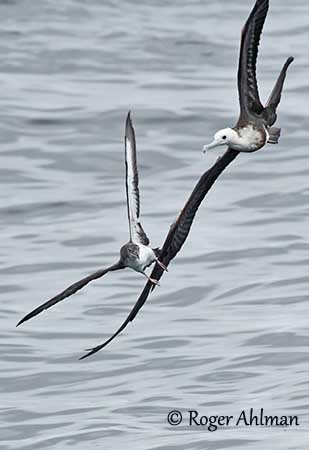
Mobbed by a juvenile
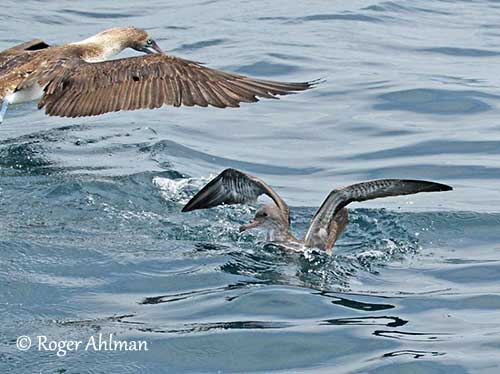
The breeding birds feed in the Humboldt Current, N of their breeding grounds. While foraging, they come into contact with the fishing industry, and numerous birds are hooked or entangled in nets.
The Pink-footed Shearwater is colonial nester and nests in self-excavated burrow often reused in several following years. They are monogamous with long-term pair-bonds.
This species is hard to observe on land, and its breeding behaviour is poorly known. The birds are active at colonies mainly at night, from dusk to just before dawn.
Before the egg-laying, the mates often rest together inside their burrow. They call softly in duet, and preen each other’s head and neck.
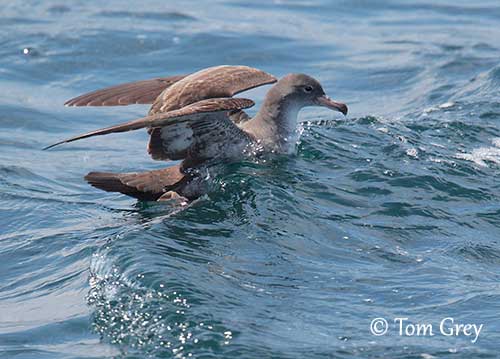
The Pink-footed Shearwater moves N after breeding, and can be seen off North America W coasts between May and November, with peak numbers in September.
They migrate N through E Pacific, and usually well offshore. Some of them reach the Gulf of Alaska. They return by the same route.
The Pink-footed Shearwater flies by gliding rather than flapping. This species is often seen tilting to the side while flying, until one wing almost touches the water surface.
It has usually slower wingbeats than the Sooty Shearwater, and it soars more than other shearwaters.
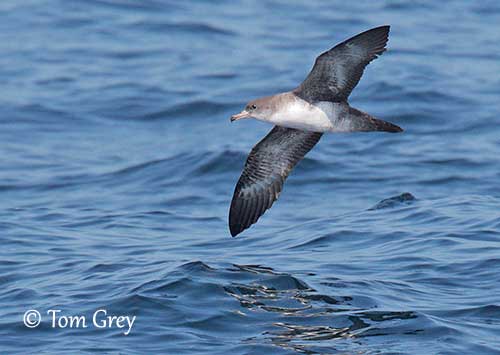
REPRODUCTION OF THIS SPECIES:
The adults usually gather near colonies in September, and by October, about two months before the egg-laying, the mated pairs are together in their burrow.
The burrow is often more than 2 metres long, with sparse lining of grass on the ground. It is dug by the birds themselves with bill and feet. Their nesting habits make them very vulnerable to introduced predators, and in addition, they compete with rabbits for nesting burrows.
The female lays a single white egg, probably early December. Both adults share the incubation during 48-56 days, but more information is required.
At hatching, the chick has greyish down above and white belly. It is fed by both parents.
The fledging period is unknown, but it is probably similar to that of the Flesh-footed Shearwater, about 92 days after hatching.
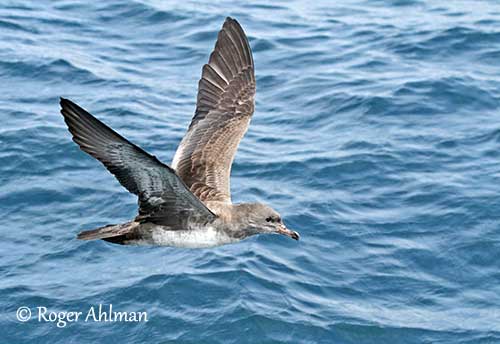
PROTECTION / THREATS / STATUS:
The Pink-footed Shearwater has very restricted breeding range on three islands where predation by introduced rats and coatis on Robinson Crusoe Island, and cats and dogs on Mocha Island, are a major threat. In addition, about 20% of the chicks are harvested by islanders on Mocha every year.
They are affected by habitat degradation on Robinson Crusoe Island, due to soil erosion by cattle, goats and rabbits, involving destruction of the burrows.
At sea, the shearwaters are entangled in fishing gear and threatened by longline commercial fishing activities in their wintering range.
Oil pollution, chemical pollutants (mercury) and plastic debris are important threats too.
The population may be around 20,000 breeding pairs, but further research is needed, in order to determine the impact of introduced predators and chick’s harvesting on Mocha Island.
However, some conservation actions are underway, and several colonies are now established in protected areas, and other conservation programmes are also in progress.
But currently, the Pink-footed Shearwater is classified as Vulnerable, and according to future declines, it could be reclassified to Endangered.
